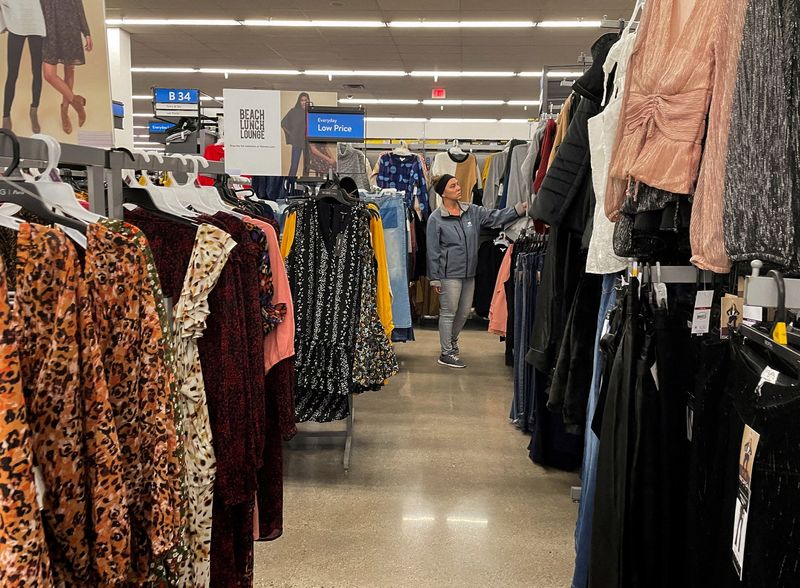By Lucia Mutikani
WASHINGTON (Reuters) - U.S. retail sales fell moderately in February, likely payback after the prior month's outsized increase, but the underlying momentum remained strong, suggesting the economy continued to expand in the first quarter despite higher borrowing costs.
The report from the Commerce Department on Wednesday, which followed on the heels of data last week showing solid job growth in February, prompted economists to upgrade their gross domestic product growth estimates for this quarter. News on inflation was somewhat encouraging. Producer prices fell last month, leading to the smallest year-on-year increase in nearly two years.
Economic data is, however, taking a backseat to the unfolding turmoil in the financial sector, where the recent failure of two regional banks has stoked fears of contagion.
That has left the outlook for next Wednesday's interest rate decision from the Federal Reserve highly uncertain.
"American consumers still appear to be spending at a rate that will make the Fed uncomfortable with the inflation outlook, warranting a further tap on the brakes," said Sal Guatieri, a senior economist at BMO Capital Markets in Toronto. "Of course, the Fed now has bigger fish to fry, making next week's decision less dependent on the data and more reliant on how the banking turmoil evolves."
Retail sales dropped 0.4% last month. Data for January was revised higher to show retail sales rising 3.2% instead of 3.0% as previously reported. Economists polled by Reuters had forecast sales would fall 0.3%, with estimates ranging from a 1.0% decline to a 0.5% increase.
Retail sales are mostly goods and are not adjusted for inflation. Economists said challenges adjusting the data for shifts in spending patterns at the end and start of the year as well as higher prices were among the factors that had exaggerated January's retail sales surge.
Last month's decline in retail sales was led by motor vehicle purchases, with receipts at auto dealers dropping 1.8% after accelerating 7.1% in January. Furniture store sales fell 2.5%, while receipts at clothing outlets decreased 0.8%.
Receipts at food services and drinking places, the only services category in the retail sales report, tumbled 2.2%. But online retail sales increased 1.6%, while receipts at electronics and appliance stores rose 0.3%.
Spending is being supported by a tight labor market, which is generating higher wage growth. There were 1.9 job openings for every unemployed person in January. Consumers still have a huge amount of savings accumulated during the COVID-19 pandemic.
Financial markets saw a 50/50 chance of a quarter-point rate hike or pause at the Fed's policy meeting next Tuesday and Wednesday, according to CME Group's (NASDAQ:CME) FedWatch tool.
The U.S. central bank has raised its benchmark overnight interest rate by 450 basis points since last March from near-zero to the current 4.50%-4.75% range.
"Recent bank failures and the spike in financial market stress are complicating policymakers' task of reading the economic tea leaves," said Oren Klachkin, lead U.S. economist at Oxford Economics in New York. "A pause in the hiking cycle would be premature as inflation continues to run hot and GDP growth remains resilient."
U.S. stocks fell on the banking sector turmoil. The dollar jumped versus a basket of currencies. U.S. Treasury prices rose.
(Graphic: Retail sales - https://www.reuters.com/graphics/USA-STOCKS/zgpobambgvd/retailsales.png)
UNDERLYING STRENGTH
According to Bank of America (NYSE:BAC) Securities, an analysis of the bank's card data showed that services spending significantly outperformed goods spending in February. While this suggests the rotation of spending back to services helped to undercut retail sales last month, it should support overall consumer spending.
Excluding automobiles, gasoline, building materials and food services, retail sales rose 0.5% last month. These so-called core retail sales increased 2.3% in January, revised up from the previously reported 1.7%.
Core retail sales correspond most closely with the consumer spending component of gross domestic product. Economists said consumer spending, which accounts for more than two-thirds of the U.S. economy, was on track to accelerate this quarter, prompting some Wall Street banks, including JPMorgan (NYSE:JPM) and Barclays (LON:BARC), to boost their GDP forecasts.
The Atlanta Fed raised its first-quarter GDP growth estimate to a 3.2% annualized rate from a 2.6% pace.
The outlook was, however, tempered by a second report from the Commerce Department showing businesses inventories fell for the first time in nearly two years in January. Inventory accumulation, most of it unwanted, was the major contributor to the economy's 2.7% growth pace in the fourth quarter.
A third report from the Labor Department showed the producer price index for final demand slipped 0.1% in February. Data for January was revised down to show the PPI increasing 0.3% instead of 0.7% as previously reported.
In the 12 months through February, the PPI increased 4.6%. That was the smallest annual gain in the PPI since March 2021 and followed a 5.7% rise in January.
(Graphic: Inflation - https://www.reuters.com/graphics/USA-STOCKS/akveqezqbvr/inflation.png)
With consumer and producer prices data in hand, economists forecast that the personal consumption expenditures (PCE) price index excluding the volatile food and energy components increased by about 0.3% in February after surging 0.6% in January. That would lower the annual increase in the so-called core PCE price index to 4.6% from 4.7% in January.

The core PCE price index is one of the inflation measures tracked by the Fed for its 2% target.
"The inflation data continues to point toward the need for more restraint on an overheated economy," said Andrew Hollenhorst, chief U.S. economist at Citigroup (NYSE:C) in New York.